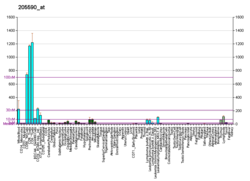RASGRP1
表示
Rasグアニル放出タンパク質1(Rasグアニルほうしゅつタンパクしつ1、RAS guanyl-releasing protein 1、RasGRP1)は、ヒトのRASGRP1遺伝子にコードされているタンパク質である[5][6][7]。
機能
[編集]RASグアニルヌクレオチド放出タンパク質 (AS guanyl nucleotide-releasing protein, RASGRP) は、Rasスーパーファミリーグアニンヌクレオチド交換因子 (GEF) ドメインの存在によって特徴付けられる遺伝子ファミリーのメンバーである。RASGRPは、ジアシルグリセロール (DAG)-制御ヌクレオチド交換ファクターとして機能し、結合したGDPをGTPに交換することによってRasタンパク質を特異的に活性化する。RASGRPは、Erk/MAPキナーゼカスケードを活性化し、T細胞およびB細胞の発達、ホメオスタシス、分化を制御する[7]。
遺伝子
[編集]異なるアイソフォームをコードしているオルタナティブスプライシング転写変種が同定されている。5'側エキソンを欠損している対応するラット遺伝子rbv7は、90-kDタンパク質をコードする通常のラット転写産物の5'および3'が切り取られた変種である。この短い転写産物はヒトでは発見されていない[7]。
臨床的重要性
[編集]このタンパク質の異なるアイソフォームの発現の変化は、全身性エリテマトーデス (SLE) 感受性の原因と考えられる[7]。
脚注
[編集]- ^ a b c GRCh38: Ensembl release 89: ENSG00000172575 - Ensembl, May 2017
- ^ a b c GRCm38: Ensembl release 89: ENSMUSG00000027347 - Ensembl, May 2017
- ^ Human PubMed Reference:
- ^ Mouse PubMed Reference:
- ^ Bottorff D, Ebinu J, Stone JC (May 1999), “RasGRP, a Ras activator: mouse and human cDNA sequences and chromosomal positions”, Mamm Genome 10 (4): 358–61, doi:10.1007/s003359901001, PMID 10087292
- ^ Kawasaki H, Springett GM, Toki S, Canales JJ, Harlan P, Blumenstiel JP, Chen EJ, Bany IA, Mochizuki N, Ashbacher A, Matsuda M, Housman DE, Graybiel AM (Nov 1998), “A Rap guanine nucleotide exchange factor enriched highly in the basal ganglia”, Proc Natl Acad Sci U S A 95 (22): 13278–83, doi:10.1073/pnas.95.22.13278, PMC 23782, PMID 9789079
- ^ a b c d Entrez Gene: RASGRP1 RAS guanyl releasing protein 1 (calcium and DAG-regulated) 2012年1月24日閲覧。
推薦文献
[編集]- Dower NA, Stang SL, Bottorff DA, Ebinu JO, Dickie P, Ostergaard HJ, Stone JC (2000), “RasGRP is essential for mouse thymocyte differentiation and TCR signaling.”, Nature Immunology 1 (4): 317–21, doi:10.1038/79766, PMID 11017103
- Priatel JJ, Teh SJ, Dower NA, Stone JC, et al. (2002), “RasGRP1 Transduces Low-Grade TCR Signals Which Are Critical For T Cell Development, Homeostasis and Differentiation.”, Immunity 17 (5): 617–27, doi:10.1016/S1074-7613(02)00451-X, PMID 12433368
- Priatel JJ, Chen X, Zenewicz LA, Shen H, Harder KW, Horwitz MS et al. (2007), “Chronic Immunodeficiency in Mice Lacking RasGRP1 Results in CD4 T Cell Immune Activation and Exhaustion.”, J. Immunol. 179 (4): 2143–52, PMID 17675473
- Priatel JJ, Chen X, Dhanji S, Abraham N, et al. (2006), “RasGRP1 Transmits Pro-Differentiation TCR Signaling that is Crucial for CD4 T Cell Development.”, J. Immunol. 177 (3): 1470–80, PMID 16849453
- Priatel JJ, Chen X, Huang YH, Chow MT, Zenewicz LA, Coughlin JJ, Shen H, Stone JC, Tan R et al. (2010), “RasGRP1 regulates antigen-induced developmental programming by naive CD8 T cells.”, J. Immunol. 184 (2): 666–76, doi:10.4049/jimmunol.0803521, PMID 20007535
- Ebinu JO, Bottorff DA, Chan EY, et al. (1998), “RasGRP, a Ras guanyl nucleotide- releasing protein with calcium- and diacylglycerol-binding motifs.”, Science 280 (5366): 1082–6, doi:10.1126/science.280.5366.1082, PMID 9582122
- Topham MK, Prescott SM (2001), “Diacylglycerol kinase zeta regulates Ras activation by a novel mechanism.”, J. Cell Biol. 152 (6): 1135–43, doi:10.1083/jcb.152.6.1135, PMC 2199204, PMID 11257115
- Strausberg RL, Feingold EA, Grouse LH, et al. (2003), “Generation and initial analysis of more than 15,000 full-length human and mouse cDNA sequences.”, Proc. Natl. Acad. Sci. U.S.A. 99 (26): 16899–903, doi:10.1073/pnas.242603899, PMC 139241, PMID 12477932
- Bivona TG, Pérez De Castro I, Ahearn IM, et al. (2003), “Phospholipase Cgamma activates Ras on the Golgi apparatus by means of RasGRP1.”, Nature 424 (6949): 694–8, doi:10.1038/nature01806, PMID 12845332
- Madani S, Hichami A, Cherkaoui-Malki M, et al. (2004), “Diacylglycerols containing Omega 3 and Omega 6 fatty acids bind to RasGRP and modulate MAP kinase activation.”, J. Biol. Chem. 279 (2): 1176–83, doi:10.1074/jbc.M306252200, PMID 14583629
- Klinger MB, Guilbault B, Goulding RE, Kay RJ (2005), “Deregulated expression of RasGRP1 initiates thymic lymphomagenesis independently of T-cell receptors.”, Oncogene 24 (16): 2695–704, doi:10.1038/sj.onc.1208334, PMID 15829980
- Liu Y, Zhu M, Nishida K, et al. (2007), “An essential role for RasGRP1 in mast cell function and IgE-mediated allergic response.”, J. Exp. Med. 204 (1): 93–103, doi:10.1084/jem.20061598, PMC 2118421, PMID 17190838
- Roose JP, Mollenauer M, Ho M, et al. (2007), “Unusual interplay of two types of Ras activators, RasGRP and SOS, establishes sensitive and robust Ras activation in lymphocytes.”, Mol. Cell. Biol. 27 (7): 2732–45, doi:10.1128/MCB.01882-06, PMC 1899892, PMID 17283063
- Ewing RM, Chu P, Elisma F, et al. (2007), “Large-scale mapping of human protein-protein interactions by mass spectrometry.”, Mol. Syst. Biol. 3 (1): 89, doi:10.1038/msb4100134, PMC 1847948, PMID 17353931
- Pasvolsky R, Feigelson SW, Kilic SS, et al. (2007), “A LAD-III syndrome is associated with defective expression of the Rap-1 activator CalDAG-GEFI in lymphocytes, neutrophils, and platelets.”, J. Exp. Med. 204 (7): 1571–82, doi:10.1084/jem.20070058, PMC 2118641, PMID 17576779
- Kosco KA, Cerignoli F, Williams S, et al. (2007), “SKAP55 modulates T cell antigen receptor-induced activation of the Ras-Erk-AP1 pathway by binding RasGRP1.”, Mol. Immunol. 45 (2): 510–22, doi:10.1016/j.molimm.2007.05.024, PMID 17658605
- Yasuda S, Stevens RL, Terada T, et al. (2007), “Defective expression of Ras guanyl nucleotide-releasing protein 1 in a subset of patients with systemic lupus erythematosus.”, J. Immunol. 179 (7): 4890–900, PMID 17878389





